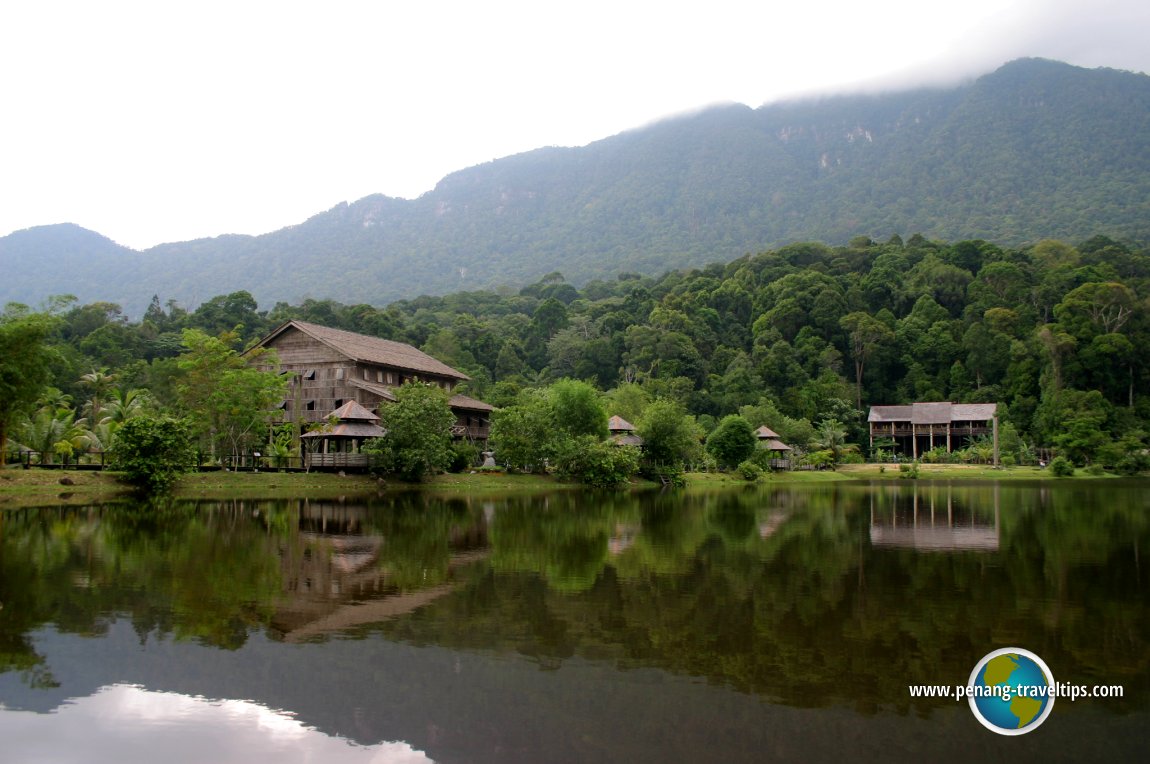
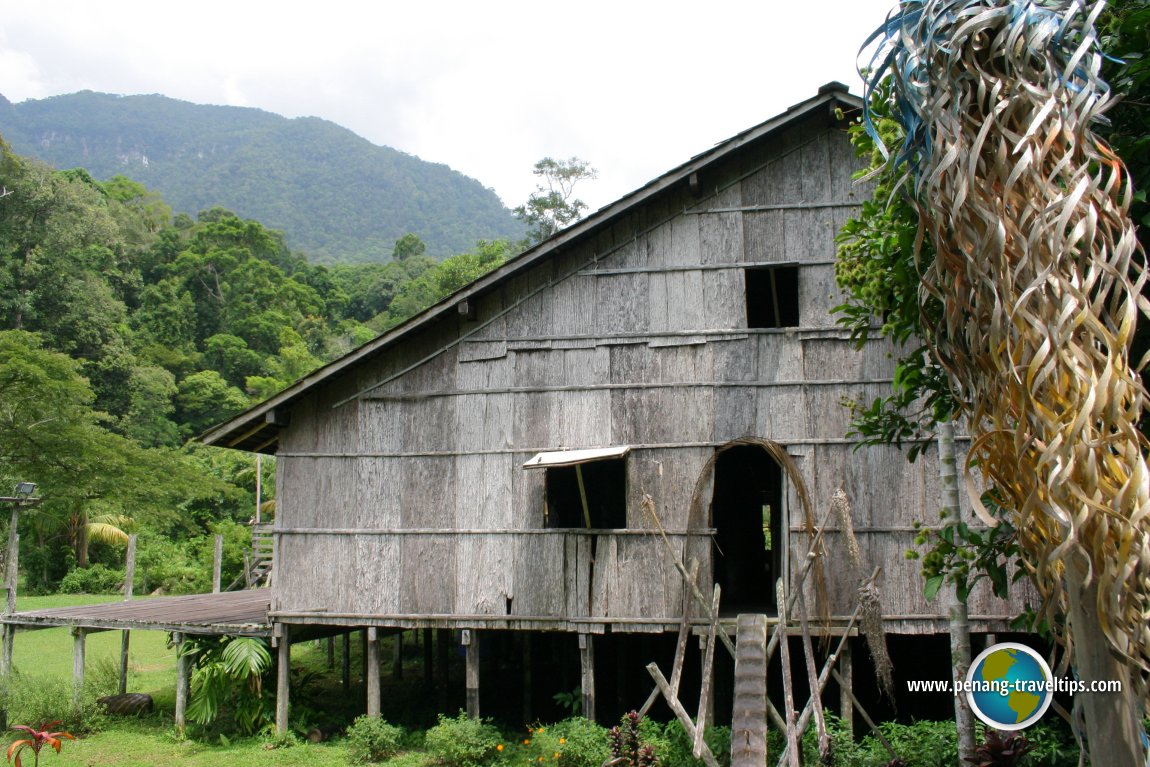 Iban longhouse, Sarawak Cultural Village (2 October, 2004)
Iban longhouse, Sarawak Cultural Village (2 October, 2004)
The Iban Longhouse (GPS: 1.74952, 110.31765) at the Sarawak Cultural Village provides a fascinating glimpse of the Iban people of Sarawak. The Ibans are the largest tribe in the state. They constitute 29.2% of the state's population. The Ibans are also called "Sea Dayaks" for they live along the lower reaches of most major rivers in Sarawak. Originally animists, Ibans are now mostly Christians. The Ibans live in longhouses, which is a row of family rooms connected by a long communal verandah.
The Iban longhouses are often found in the lower and middle reaches of major rivers of Sarawak, such as the Rajang river delta and the Kapuas river delta. That's because the Ibans prefer living in the lowlands, and thus were known during the colonial period as the Sea Dayaks.
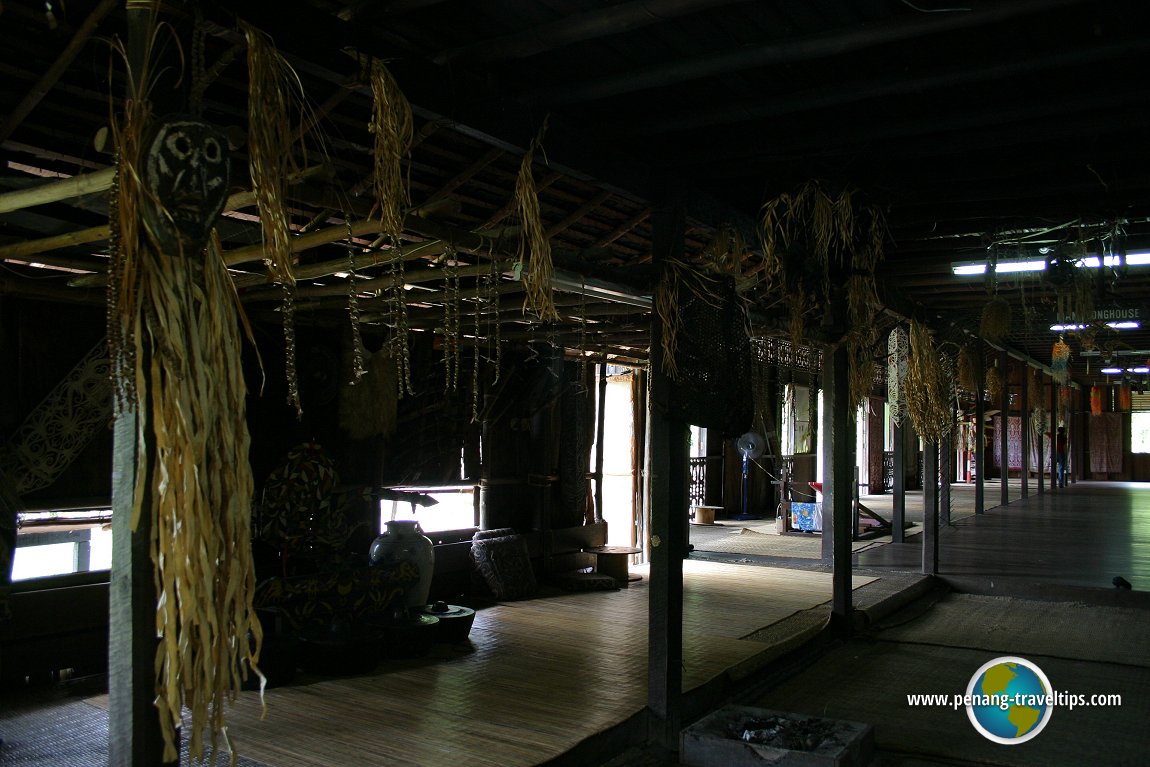 The inside of the Iban longhouse (2 October, 2004)
The inside of the Iban longhouse (2 October, 2004)
Ibans celebrate many festivals, called Gawai, which follow the farming cycle. In addition, minor illnesses may require performing a ceremony to heal it, while weddings and funerals call for a more elaborate affair.
The biggest festivals for the Ibans, such as Gawai Kenyalang or hornbill festival, and Gawai Antu or festival for the departed are rarely staged, for they require long preparation and expense.
The Ibans' Gawai Antu may happen only once every generation, or even more likely, once a century. If it happens at all, it usually takes place in November or December. Central to this Iban festival is the construction of a small, beautifully carved hut called sungkup which is placed in the graveyards. Made of belian ironwood, the sungkup is roughly 6 ft long by 4 ft wide, and 3 ft high, with curved wings on the ends of the roof, from which baskets are tied. The festival includes one night of ritual weeping.
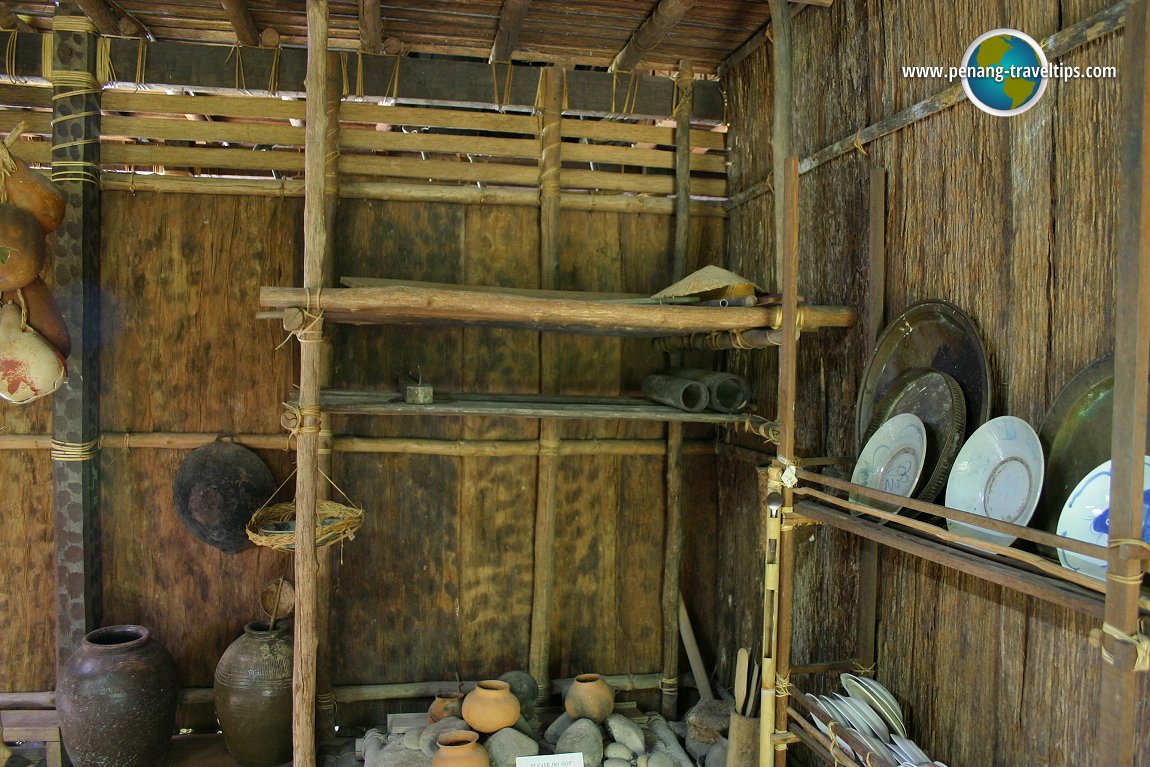 Living quarters inside the Iban longhouse (2 October, 2004)
Living quarters inside the Iban longhouse (2 October, 2004)
The Iban womenfolk are gifted at weaving. They produce artistic textiles using the wrap-ikat technique. This technique calls for threads to be tied and dyed before weaving. One use of this technique is in the making of the Iban ceremonial cloth called the Pua Kumbu.
Until a few generations ago, the Ibans still practised headhunting. Indeed, an Iban man was not considered eligible for marriage until he had produced this gruesome token of courage. The Ibans have a whole set of words connected to headhunting - bedengah means having taken an enemy's head, udah ngerok means having scrapped the brain from the enemy skull, and tau nasak is a person who has done all that.
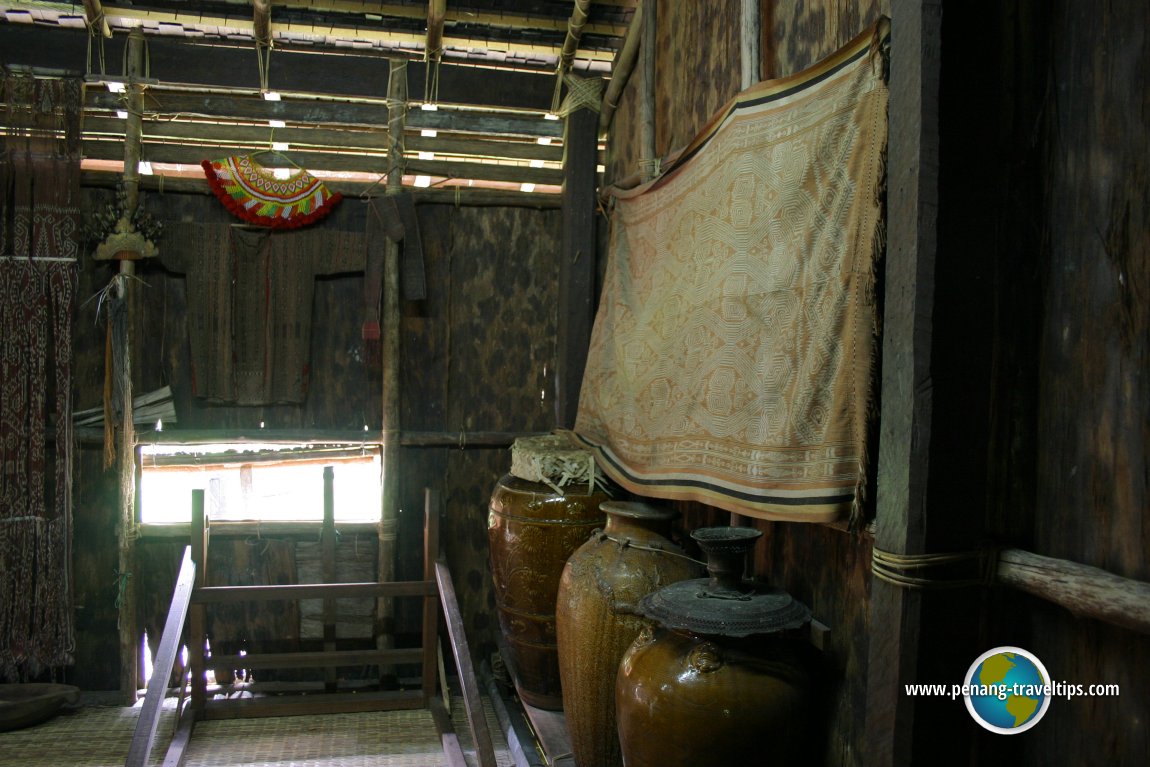 Martaban jars in the Iban longhouse (2 October, 2004)
Martaban jars in the Iban longhouse (2 October, 2004)
In the assembly of Iban tribal elders, a person with many heads is reverred as a wise counsellor. The prize heads are hanged over small fireplaces in the Iban longhouse verandah, displayed for all to see and form their own conclusion. Offerings are made to these severed heads during festivals, for the Ibans believe that properly placated heads bring blessings while neglected ones may summon misfortune.
In addition to the heads, the Pua Kumbu, the gongs and cannon, one prized possession among the Ibans and many other Borneo tribes are Martaban jars. These are usually made in China, though the name cames from the Gulf of Martaban in Myanmar. These massive jars are Iban family heirloom and are highly valued. Some believe that they carry magical properties, able to cure illnesses or summon spirtis when gently struck. Some are said to emit a human sound to warn their owners of impending disasters.
The Ibans were traditionally animists, but many are now Christians.
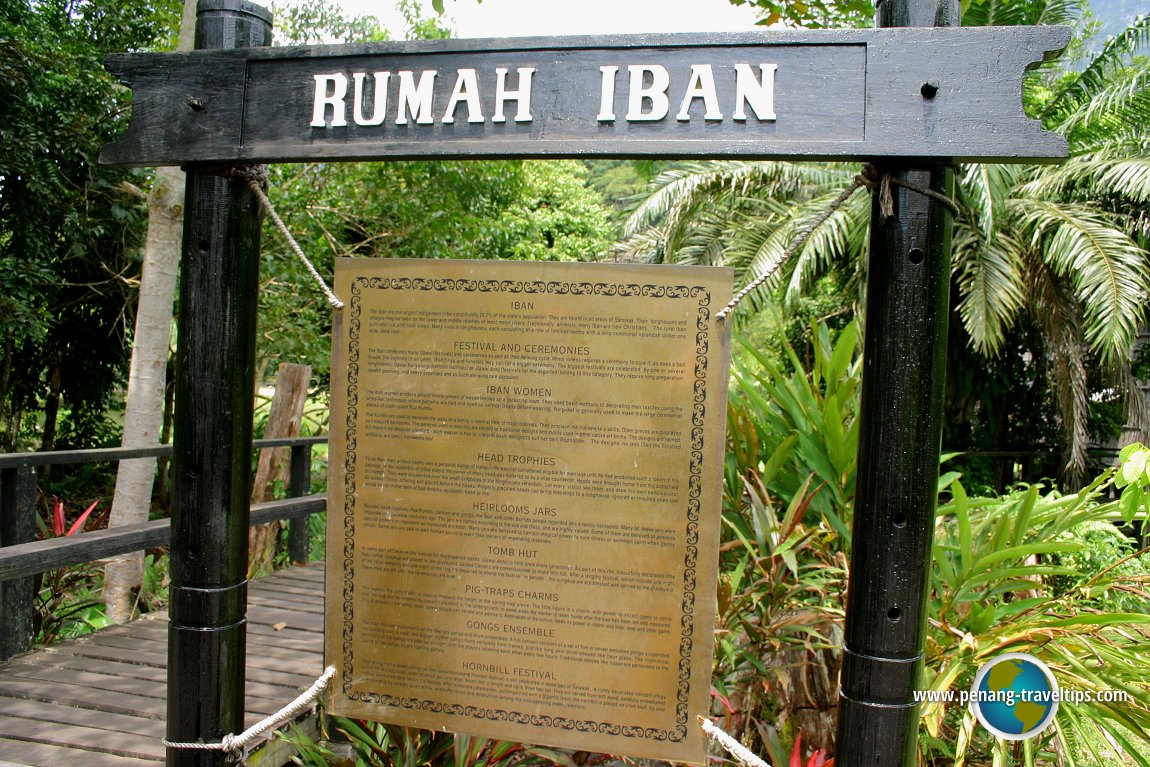 Iban longhouse interpretive plaque (2 October, 2004)
Iban longhouse interpretive plaque (2 October, 2004)
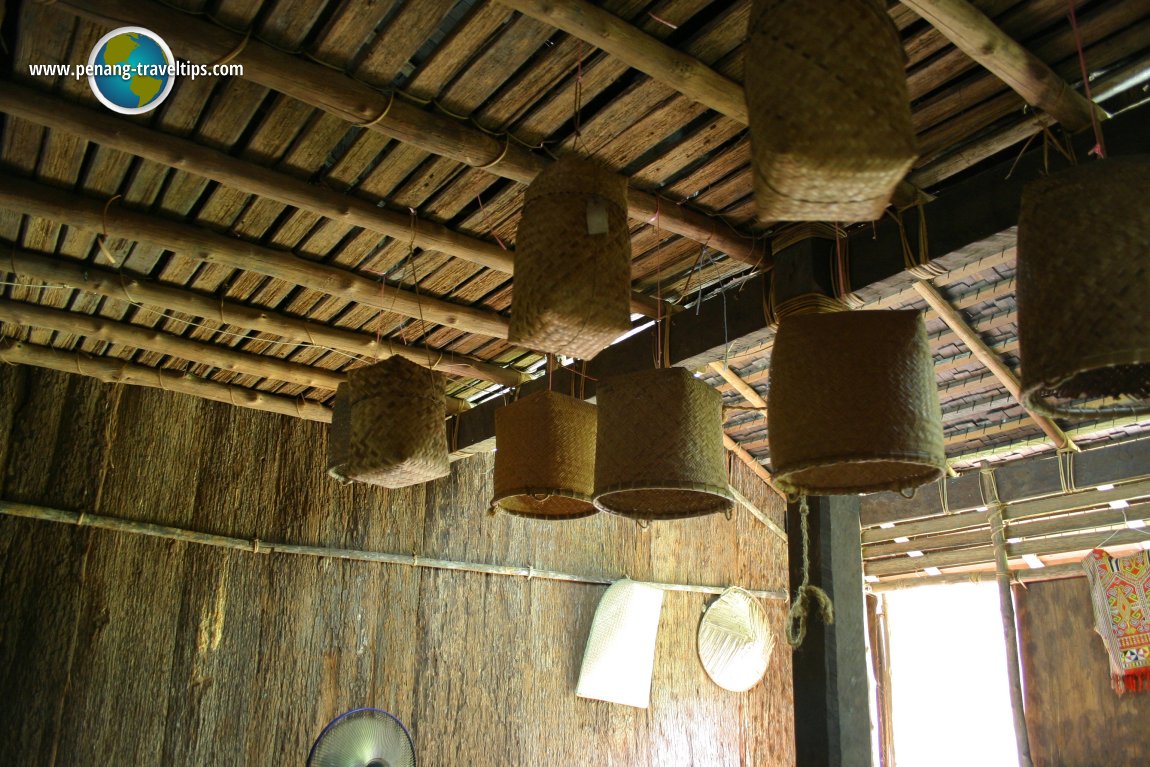 Basketware, hanging from the rafters of the Iban longhouse. (2 October, 2004)
Basketware, hanging from the rafters of the Iban longhouse. (2 October, 2004)
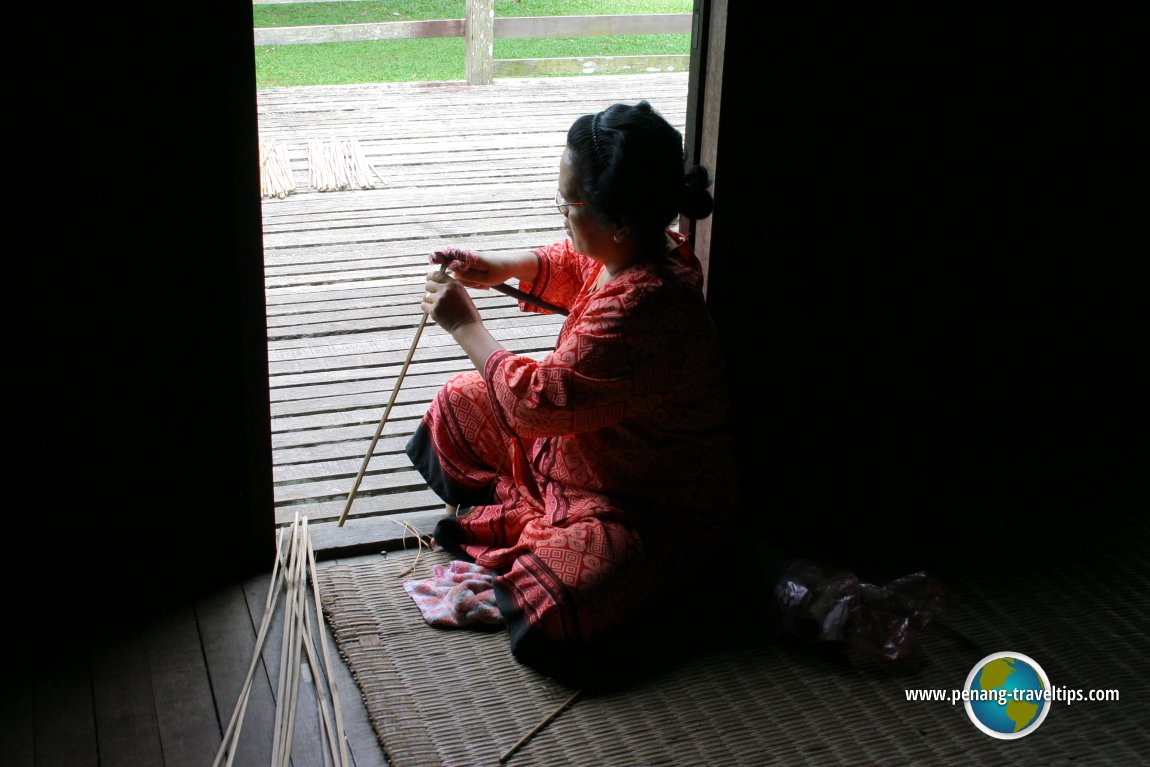 Iban woman splitting rattan at doorway of the longhouse. (2 October, 2004)
Iban woman splitting rattan at doorway of the longhouse. (2 October, 2004)
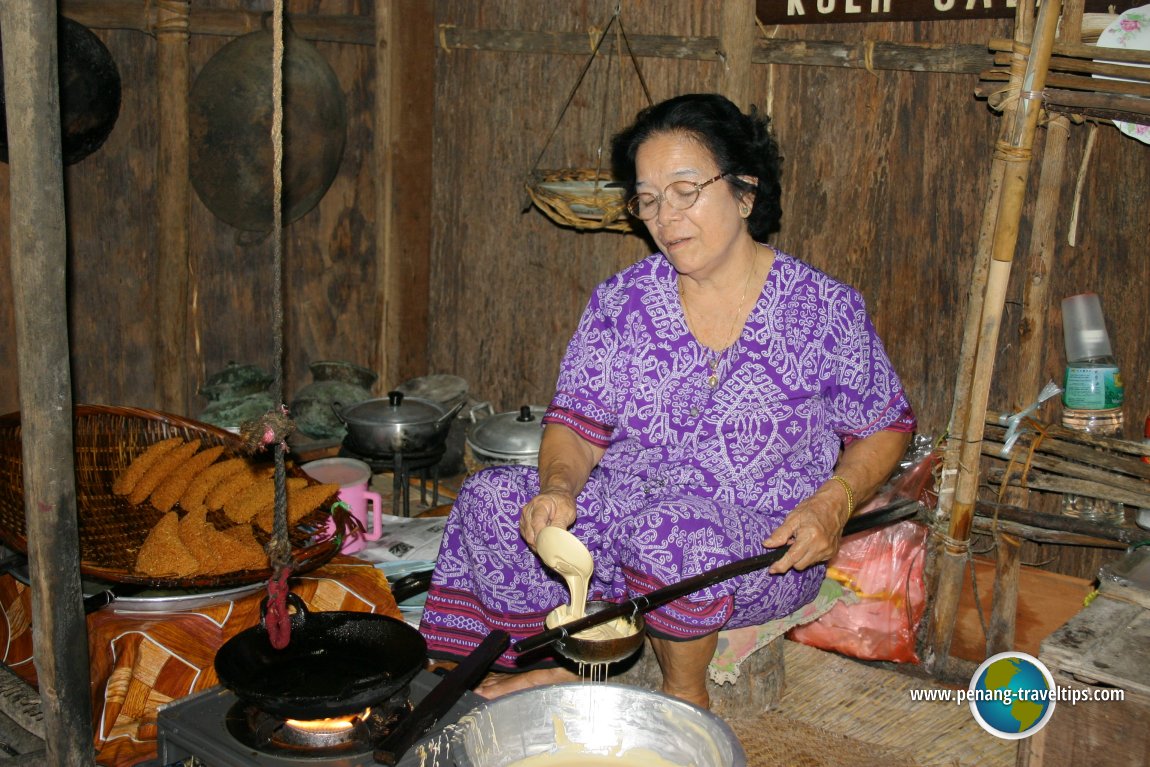 Iban woman making kuih karas. I thought this is a Malay kuih, but apparently it is made by the Ibans also, though they call it kueh jala here. (2 October, 2004)
Iban woman making kuih karas. I thought this is a Malay kuih, but apparently it is made by the Ibans also, though they call it kueh jala here. (2 October, 2004)
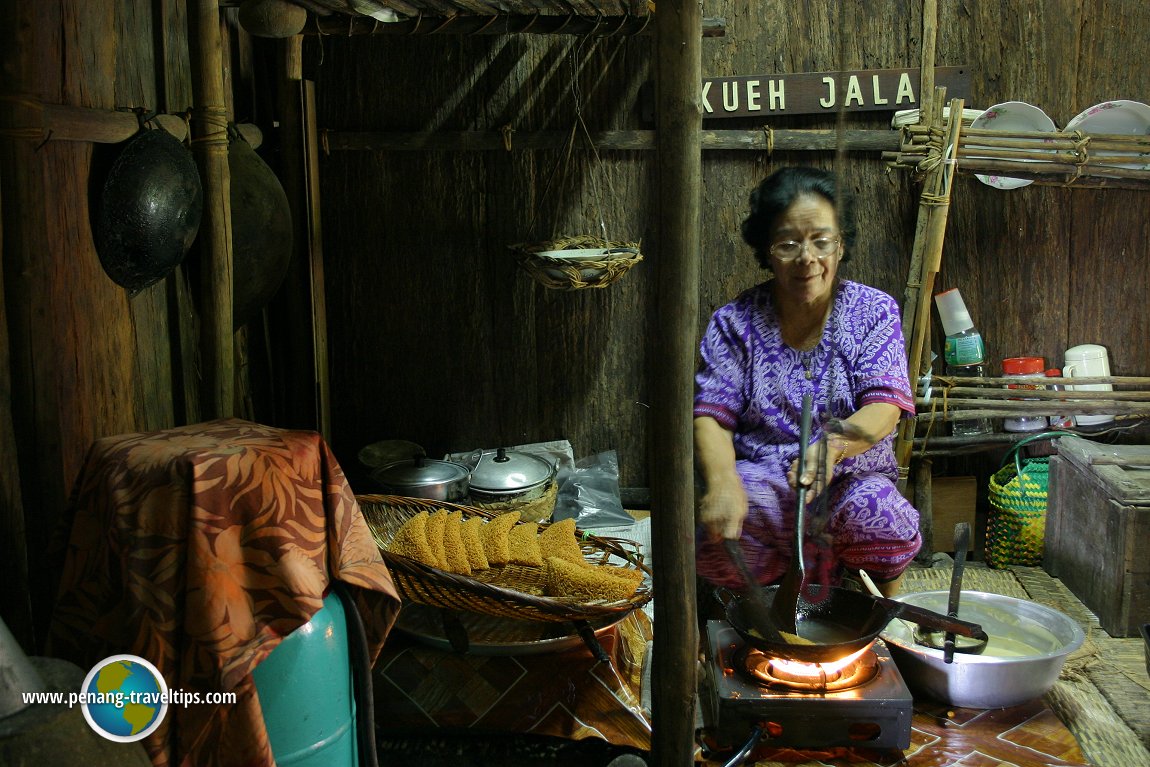 Making kueh jala in the Iban longhouse. Hmm ... I now noticed that she covers her gas tank. To me, that isn't a good idea. (2 October, 2004)
Making kueh jala in the Iban longhouse. Hmm ... I now noticed that she covers her gas tank. To me, that isn't a good idea. (2 October, 2004)
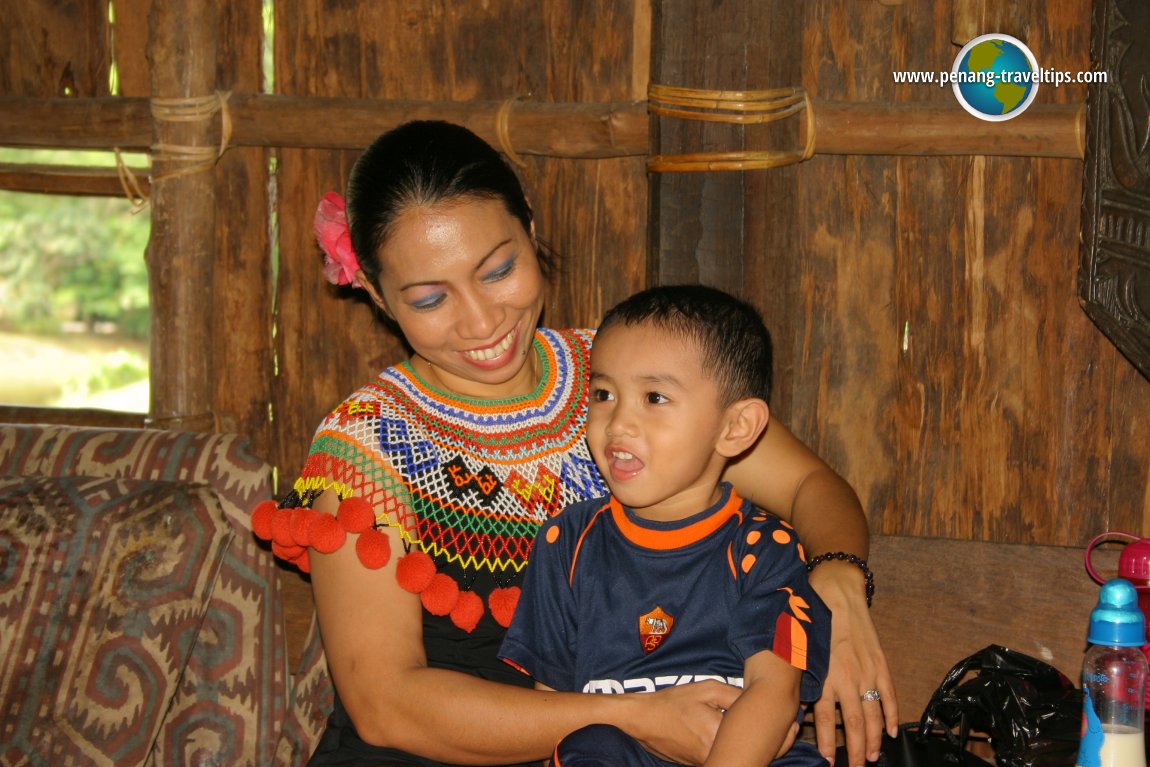 Iban young lady with child (2 October, 2004)
Iban young lady with child (2 October, 2004)
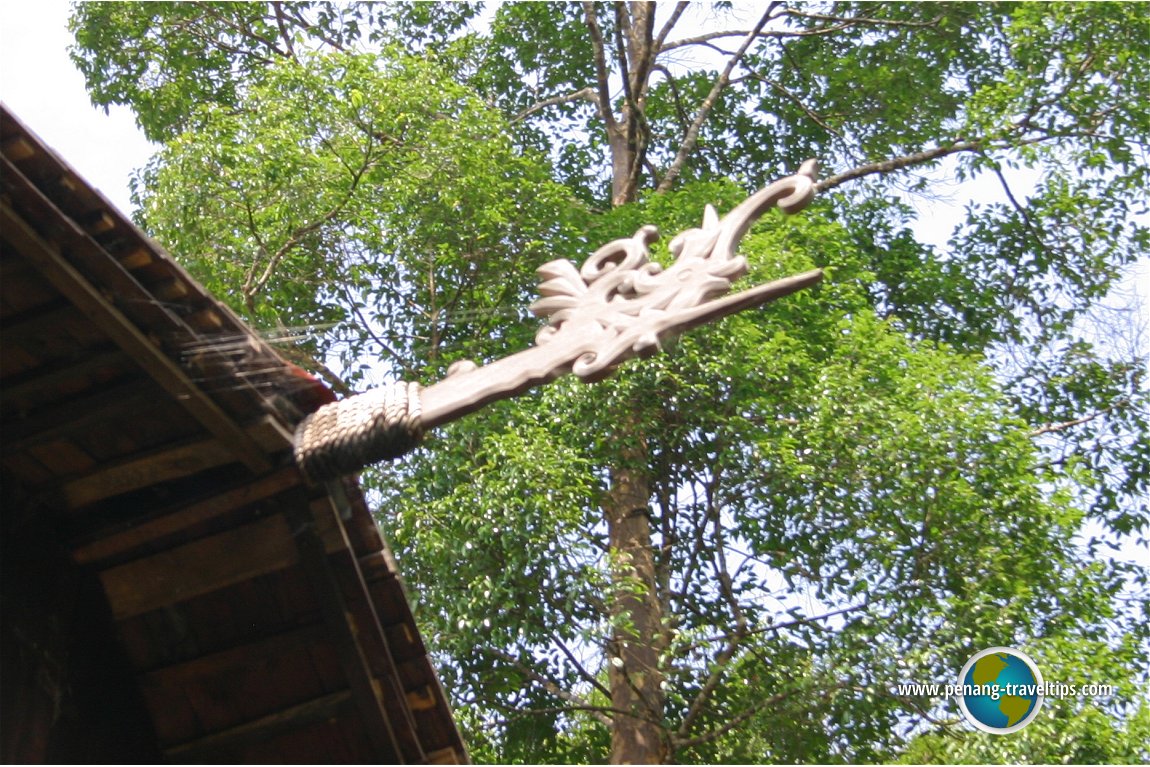 A stylized hornbill finial at the gable of the Iban longhouse (2 October, 2004)
A stylized hornbill finial at the gable of the Iban longhouse (2 October, 2004)
Return to Sarawak Cultural Village main page
DetailsBack to Discover Kuching mainpage
 Latest updates on Penang Travel Tips
Latest updates on Penang Travel Tips
About this website

Dear visitor, thank you so much for reading this page. My name is Timothy Tye and my hobby is to find out about places, write about them and share the information with you on this website. I have been writing this site since 5 January 2003. Originally (from 2003 until 2009, the site was called AsiaExplorers. I changed the name to Penang Travel Tips in 2009, even though I describe more than just Penang but everywhere I go (I often need to tell people that "Penang Travel Tips" is not just information about Penang, but information written in Penang), especially places in Malaysia and Singapore, and in all the years since 2003, I have described over 20,000 places.
While I try my best to provide you information as accurate as I can get it to be, I do apologize for any errors and for outdated information which I am unaware. Nevertheless, I hope that what I have described here will be useful to you.
To get to know me better, do follow me on Facebook!
Copyright © 2003-2025 Timothy Tye. All Rights Reserved.

 Go Back
Go Back